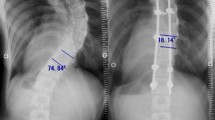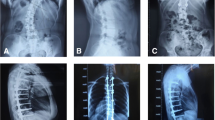Abstract
Study design
Review of prospective database.
Objectives
To report the results of Ponte osteotomy with pedicle screw instrumentation for major thoracic adolescent idiopathic (AIS) curves. p ]Summary of background data: Ponte osteotomy for achieving coronal and sagittal correction of major thoracic curves in AIS with pedicle screw instrumentation is a widespread technique, but results have not been well described.
Methods
Review of 87 consecutive AIS patients with Lenke 1—4 curves who underwent Ponte osteotomies and pedicle screw instrumentation by 2 surgeons at a single institution. Surgical details, blood loss, and complications were recorded. We evaluated coronal and sagittal radiological measurements and Scoliosis Research Society-22 (SRS-22) questionnaire scores over 2-year follow-up. p ]Results: The mean preoperative thoracic coronal Cobb angle was 57° ± 9.7°, fulcrum flexibility was 47.2%, and lateral Cobb angle was 17.8° ± 4°. The mean estimated blood loss (EBL), expressed as percent estimated blood volume, was 35.8 ± 20.5 mL. There was significant improvement in coronal thoracic Cobb angle, percent correction, and apical vertebral translation over 2-year follow-up (p <.05). In hypokyphotic curves, there was a significant increase in lateral thoracic T5-T12 kyphosis from 8.1° to 18.3° (p <.001). In hyperkyphotic curves, mean lateral thoracic T5—T12 kyphosis improved from 45° to 26° (p <.001). Median SRS-22 domains were higher after treatment (p <.05). Complications included significant hypotension (1), EBL greater than 75% estimated blood volume (2), and wound infection needing drainage (2). There were neuromonitoring signal changes in 7 patients but no significant neurological complications.
Conclusions
In this case series of major thoracic AIS curves treated with segmental pedicle screw instrumentation and Ponte osteotomies, there was an improvement in the coronal and sagittal radiological parameters. A prospective controlled study is needed to determine whether pedicle screw instrumentation and Ponte osteotomies influence outcomes and complications.
Similar content being viewed by others
References
Hibbs RA. A report of fifty-nine cases of scoliosis treated by the fusion operation. J Bone Joint Surg Am 1924;6:3–34.
Moe JH. A critical analysis of methods of fusion for scoliosis: an evaluation in two hundred and sixty-six patients. J Bone Joint Surg Am 1958;40:529–54.
Smith-Petersen MN, Larson CB, Aufranc OE. Osteotomy of the spine for correction of flexion deformity in rheumatoid arthritis. J Bone Joint Surg Am 1945;27:1–11.
Lagrone MO, Bradford DS, Moe JH, et al. Treatment of symptomatic flatback after spinal fusion. J Bone Joint Surg Am 1988;70: 569-80.
Voos K, Boachie-Adjei O, Rawlins BA. Multiple vertebral osteotomies in the treatment of rigid adult spine deformities. Spine (Phila Pa 1976) 2001;26:526–33.
McMaster MJ. A technique for lumbar spinal osteotomy in ankylosing spondylitis. J Bone Joint Surg Br 1985;67:204–10.
Kostuik JP, Maurais GR, Richardson WJ, et al. Combined single stage anterior and posterior osteotomy for correction of iatrogenic lumbar kyphosis. Spine (Phila Pa 1976) 1988;13:257–66.
Cho KJ, Bridwell KH, Lenke LG, et al. Comparison of Smith-Petersen versus pedicle subtraction osteotomy for the correction of fixed sagittal imbalance. Spine (Phila Pa 1976) 2005;30:2030–7.
Ponte A, Vero B, Siccardi GL. Surgical treatment of Scheuermann’s hyperkyphosis. In: Winter RB, editor. Kyphosis (Progress in Spinal Pathology). Bologna, Italy: Aulo Gaggi; 1984. p. 75–80.
Ponte A. Posterior column shortening for Scheuermann’s kyphosis: an innovative one-stage technique. In: Haher T, Merola A, editors. Surgical Techniques for the Spine. 1st ed. New York, NY: Thieme Verlag; 2003. p. 107–13.
Shufflebarger HL, Clark CE. Effect of wide posterior release on correction in adolescent idiopathic scoliosis. J Pediatr Orthop B 1998;7:117–23.
Shufflebarger HL, Geek MJ, Clark CE. The posterior approach for lumbar and thoracolumbar adolescent idiopathic scoliosis: posterior shortening and pedicle screws. Spine (Phila Pa 1976) 2004;29:269–76.
Geek MJ, Macagno A, Ponte A, et al. The Ponte procedure: posterior only treatment of Scheuermann’s kyphosis using segmental posterior shortening and pedicle screw instrumentation. J Spinal Disord Tech 2007;20:586–93.
Kim YJ, Lenke LG, Kim J, et al. Comparative analysis of pedicle screw versus hybrid instrumentation in posterior spinal fusion of adolescent idiopathic scoliosis. Spine (Phila Pa 1976) 2006;31:291–8.
Liljenqvist U, Lepsien U, Hackenberg L, et al. Comparative analysis of pedicle screw and hook instrumentation in posterior correction and fusion of idiopathic thoracic scoliosis. Eur Spine J 2002;11:336–43.
Lowenstein JE, Matsumoto H, Vitale MG, et al. Coronal and sagittal plane correction in adolescent idiopathic scoliosis: a comparison between all pedicle screw versus hybrid thoracic hook lumbar screw constructs. Spine (Phila Pa 1976) 2007;32:448–52.
Imrie M, Yaszay B, Bastrom TP, et al. Adolescent idiopathic scoliosis: should 100% correction be the goal? J Pediatr Orthop 2011;31(1 Suppl):S9–13.
Newton PO, Yaszay B, Upasani VV, et al. Preservation of thoracic kyphosis is critical to maintain lumbar lordosis in the surgical treatment of adolescent idiopathic scoliosis. Spine (Phila Pa 1976) 2010;35:1365–70.
Halanski MA, Cassidy JA. Do multilevel Ponte osteotomies in thoracic idiopathic scoliosis surgery improve curve correction and restore thoracic kyphosis? J Spinal Disord Tech 2011 Dec 21 [Epub ahead of print].
Pizones J, Izquierdo E, Sanchez-Mariscal F, et al. Does wide posterior multiple level release improve the correction of adolescent idiopathic scoliosis curves? J Spinal Disord Tech 2010;23:e24–30.
Kim YJ, Lenke LG, Bridwell KH, et al. Free hand pedicle screw placement in the thoracic spine: is it safe? Spine (Phila Pa 1976) 2004;29:333–42.
Shah SA. Derotation of the spine. Neurosurg Clin N Am 2007;18:339–45.
Luk KD, Cheung KM, Lu DS, et al. Assessment of scoliosis correction in relation to flexibility using the fulcrum bending correction index. Spine (Phila Pa 1976) 1998;23:2303–7.
Diab MG, Franzone JM, Vitale MG. The role of posterior spinal osteotomies in pediatric spinal deformity surgery: indications and operative technique. J Pediatr Orthop 2011;31:S88–98.
Sucato DJ, Agrawal S, O’Brien MF, et al. Restoration of thoracic kyphosis after operative treatment of adolescent idiopathic scoliosis: a multicenter comparison of three surgical approaches. Spine (Phila Pa 1976) 2008;33:2630–6.
Lehman Jr RA, Lenke LG, Keeler KA, et al. Operative treatment of adolescent idiopathic scoliosis with posterior pedicle screw-only constructs: minimum three-year follow-up of one hundred fourteen cases. Spine (Phila Pa 1976) 2008;33:1598–604.
Suk SI, Lee SM, Chung ER, et al. Selective thoracic fusion with segmental pedicle screw fixation in the treatment of thoracic idiopathic scoliosis: more than 5-year follow-up. Spine (Phila Pa 1976) 2005;30:1602–9.
Coe JD, Arlet V, Donaldson W, et al. Complications in spinal fusion for adolescent idiopathic scoliosis in the new millennium: a report of the Scoliosis Research Society Morbidity and Mortality Committee. Spine (Phila Pa 1976) 2006;31:345–9.
Author information
Authors and Affiliations
Corresponding author
Additional information
Author disclosures: SAS (grant from the Setting Scoliosis Straight Foundation; provision of writing assistance, medicines, equipment, or administrative support from Harms Study Group; board membership with Scoliosis Research Society and Setting Scoliosis Straight Foundation; patents from DePuy Synthes Spine; AAD (none); JEO (none); PY (none); GIN (none); LH (none); PGG (payment for lecture from DePuy Synthes Spine).
Corporate or industry funds were received to support this work. Although one or more of the author(s) has/have received or will receive benefits for personal or professional use from a commercial party related directly or indirectly to the subject of this manuscript, benefits will be directed solely to a research fund, foundation, educational institution, or other nonprofit organization that the author(s) has/have been associated with.
Rights and permissions
About this article
Cite this article
Shah, S.A., Dhawale, A.A., Oda, J.E. et al. Ponte Osteotomies With Pedicle Screw Instrumentation in the Treatment of Adolescent Idiopathic Scoliosis. Spine Deform 1, 196–204 (2013). https://doi.org/10.1016/j.jspd.2013.03.002
Received:
Revised:
Accepted:
Published:
Issue Date:
DOI: https://doi.org/10.1016/j.jspd.2013.03.002




